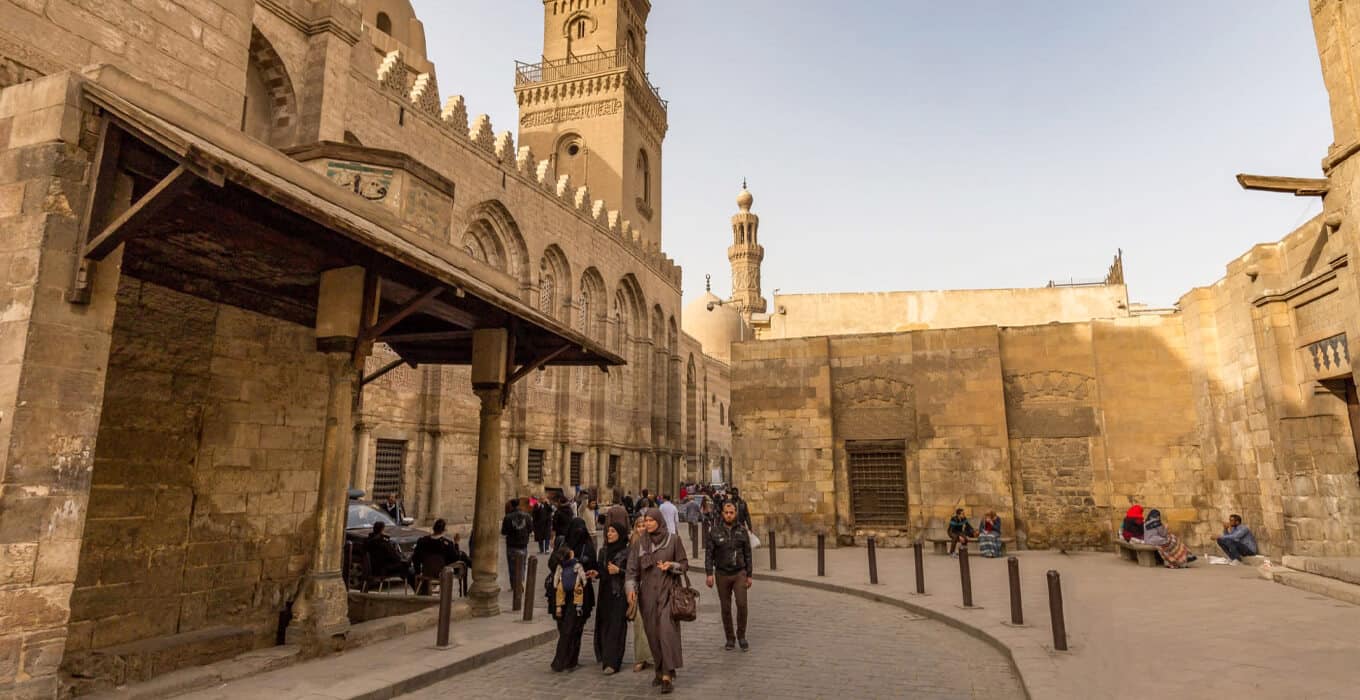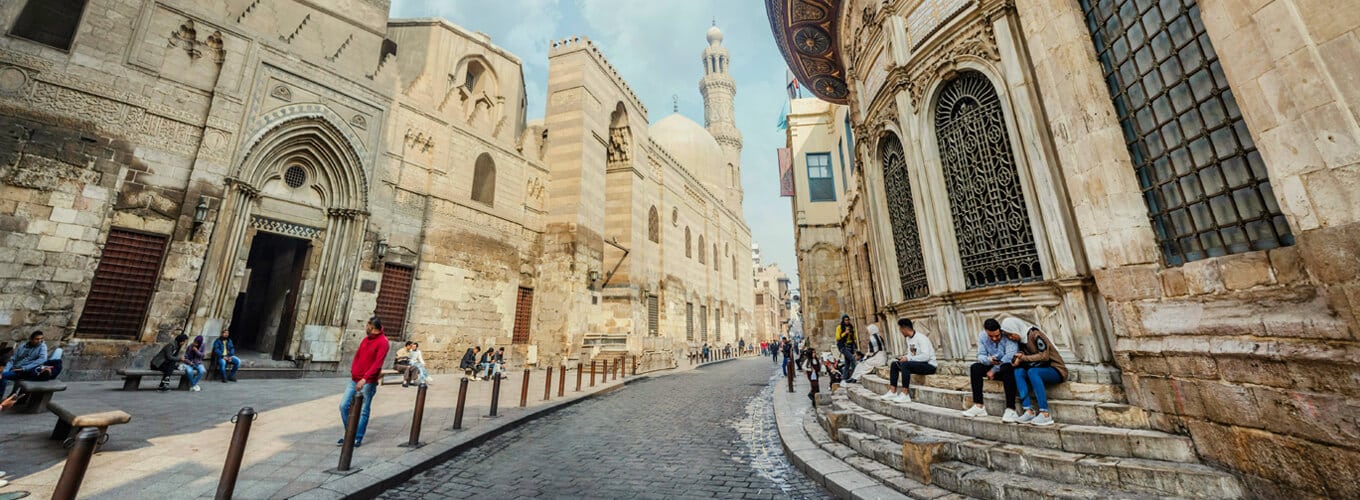Imagine walking through a place where old and new meet. Welcome to Muizz Street, a 10th-century street in Historic Cairo. It’s a UNESCO World Heritage Site that shows the beauty of Islamic civilization.
This street, also called Al-Mu’izz li-Din Allah Al-Fatimi Street, invites you to see its amazing architecture and traditions. It’s a place where history and culture come alive.
What secrets does Muizz Street hold? How can you experience its history? Let’s go on a journey to discover this special place. We’ll explore its past and present, where history meets today.
Key Takeaways
- Muizz Street is a 10th-century road in Islamic Cairo, known for its high concentration of medieval architecture.
- The street served as the economic hub of the city during the Fatimid dynasty and remained central through the Ayyubid, Mamluk, and Ottoman eras.
- Visitors can explore a diverse array of Fatimid, Ayyubid, and Mamluk-era monuments, including mosques, madrasas, and caravanserais.
- Muizz Street is a UNESCO World Heritage Site and one of the best open-air museums in Egypt, showcasing the rich cultural heritage of Islamic Cairo.
- The street offers a unique opportunity to immerse oneself in the sights, sounds, and traditions of medieval Islamic civilization.
Introduction to Historic Muizz Street
In the heart of Historic Old Cairo, Muizz Street shows off the city’s Islamic heritage. It’s a long street, about a kilometer long, known as one of the longest in the old city. It takes you back in time to Egypt’s past.
Overview of Muizz Street’s Significance
Muizz Street is more than just a street. It was a key part of the Fatimid Dynasty‘s new capital, Al-Qahira (now Cairo). It saw the rise and fall of many Caliphates that changed the area. The street’s buildings and landmarks tell the story of Cairo’s long history.
Brief History of Islamic Cairo
Historic Cairo started with the city of Fustat in 641 AD. It was Egypt’s capital under early Islamic Caliphates. Then, with the Fatimid Jawhar in 969 AD, Al-Qahira was built northeast of Fustat. It became the Fatimid dynasty’s new center of power.
Muizz Street: The Main Artery of Medieval Cairo
During the Fatimid period, Muizz Street was the main street of Cairo. It linked the city’s northern and southern gates. But, after the Ayyubid and Mamluk dynasties took over, the city changed a lot. They were Sunni Muslims who wanted to remove the Shiite Fatimid mark. They tore down many Fatimid buildings and built their own.
The rulers moved their base from Muizz Street to the Citadel south of the city. This was done by Saladin in 1176. Yet, Muizz Street stayed a key spot for trade and culture. It’s now a pedestrian area, making it easier to explore.
Today, it’s lined with Mamluk and Ayyubid landmarks. You can see the Al-Hakim Mosque, Al Aqmar Mosque, and the Bayn al-Qasryn complex. These places show the mix of styles that shaped Cairo’s history.
| Landmark | Significance | Year Constructed |
| Al-Hakim Mosque | One of the oldest mosques in Cairo, built by the Fatimid dynasty | 990-1013 AD |
| Al Aqmar Mosque | Showcases the Fatimid architectural style, founded during the reign of Al Mustansir | Unknown |
| Bayn al-Qasryn | Impressive complex of Mamluk palatial buildings, dating back to 1279, 1304, and 1386 | 1279-1386 |
Muizz Street’s history and architecture are a big draw for visitors. The street’s markets, crafts, and tours offer a deep dive into Islamic Cairo’s past. It’s a chance to experience the city’s history up close.
Architectural Treasures Along Muizz Street
Muizz Street is a key part of medieval Cairo. It’s filled with historic Islamic architecture. This street has kept many important buildings from the Fatimid, Ayyubid, and Mamluk times.
Fatimid Era Monuments
The Fatimid dynasty ruled Egypt from the 10th to the 12th century. They left a big mark on Muizz Street. The Bab al-Futuh and Bab al-Nasr city gates show their great architecture.
The Al-Hakim Mosque was made by the Fatimid caliph Al-Hakim bi-Amr Allah. It’s a key building that shows off Fatimid design.
Ayyubid and Mamluk Era Landmarks
When the Fatimids were replaced by the Ayyubid and Mamluk dynasties, new buildings appeared on Muizz Street. The Sulayman Agha Al-Silahdar Mosque is a beautiful Ayyubid building. The Beshtak Palace is a rare Mamluk home that visitors can see.
The Al-Aqmar Mosque has a detailed facade. It shows the Mamluk era’s unique style. This adds to the mix of historic buildings on Muizz Street.
Exploring the Vibrant Khans and Markets
Beyond the impressive monuments on Muizz Street, there’s a bustling marketplace. It’s full of artisans and traditional handicrafts. At its heart is the famous Khan el-Khalili, Egypt’s biggest souk (bazaar).
Khan el-Khalili: A Shopper’s Delight
The Khan el-Khalili stretches from Muizz Street to the Saiyidna al-Hussein Mosque. It’s full of local handicrafts. You’ll find beautiful copper and leather goods, and more. This market, started in 1382, has a unique oriental feel. It draws visitors with its bright colors and enticing smells.
| Highlights of Khan el-Khalili | Key Facts |
|
|
The Khan el-Khalili market is more than a place to shop. It’s a window into Cairo’s rich past. It was key in the spice trade under the Mamluks. Now, it still charms visitors with its timeless beauty and lasting appeal.
Muizz Street’s Restoration and Revitalization
In 1997, the Egyptian government started a big restoration and renovation project on Muizz Street in Islamic Cairo. They wanted to make this famous street an “open-air museum.” This would highlight the area’s rich history and culture.
The restoration aimed to bring back the street’s old look. Buildings were made shorter and painted the right colors. The street was also fixed up with traditional paving and new outdoor lighting for night.
On April 24, 2008, Muizz Street became a special pedestrian zone from 8 a.m. to 11 p.m. Only cargo cars could go there outside these hours. This change made the street a lively place for people, away from cars.
The big work on Muizz Street has been seen as a huge win for keeping Islamic Cairo’s culture alive. Now, the street is like a museum outside. Visitors can feel the old Egypt’s charm in a place that’s also easy to walk around in.

Practical Tips for Visiting Muizz Street
Visiting Muizz Street in Islamic Cairo is a must for travelers. Here are some tips to enhance your visit:
Getting There and Ticketing Information
Getting to Muizz Street is easy. Just ask a taxi or Uber to drop you at Bab al-Futuh gate in Gamaleya. The street is free to visit. But, some places like the Qalawun Complex need a ticket.
You can buy a ticket at the Qalawun Complex. It gives you access to several important sites.
Best Time to Visit and Guided Tours
Muizz Street is open all day and night. But, some places are closed on Sundays and during Ramadan. For a better visit, go early in the morning or late afternoon.
Guided tours are a great way to learn about Muizz Street’s history and architecture. They make the visit more interesting.
Exploring Muizz Street, with or without a guide, is a unique experience. It shows the beauty of Islamic Cairo.
Muizz Street: A Living Museum
Walking along Muizz Street from Bab al-Futuh to Bab Zuweila is like a trip through Islamic history. This street is full of architectural treasures from the Fatimid, Ayyubid, Mamluk, and Ottoman times.
From big city gates to fancy mosques, madrasas, and palaces, Muizz Street is a living museum. It lets visitors dive into the rich culture of Islamic Cairo. You can see traditional Egyptian crafts and visit the Qalawun Complex from the 13th century and the famous Al-Azhar Mosque, which started in 970 AD.
There are cultural events and festivals on Muizz Street all year. It’s a safe place for tourists, with tourist police around. This makes it a great spot for visitors to Cairo.
Whether it’s day or night, Muizz Street offers a unique experience. It lets visitors see the lasting impact of Islamic architecture and cultural heritage. The street is getting more popular thanks to its ongoing restoration.
| Historic Highlights of Muizz Street | Construction Period |
| Mosque of Al-Hakim bi Amr Allah | 1013 AD |
| Sabil-Kuttab of Abdel Rahman Katkhuda | 1744 AD |
| Qalawun Complex | 13th century AD |
| Al-Azhar Mosque | 970 AD |
Conclusion
Muizz Street in Islamic Cairo is a key part of the city’s history and culture. It’s the main street of the old Fatimid capital. Here, visitors can see the amazing work of Islamic dynasties like the Fatimids, Mamluks, and Ottomans.
This street is full of old monuments, busy markets, and a lively feel. It’s a special place that shows what Islamic Cairo is all about. It’s a UNESCO World Heritage Site.
Visitors can see the beautiful tile work and calligraphy at the Sultan Al-Ghuri Complex. Or, they can enjoy the Khan el-Khalili Bazaar’s fun atmosphere. Muizz Street offers a memorable trip through the heart of this amazing city.
Walking the narrow alleys and seeing the historic spots on Muizz Street helps you appreciate Islamic architecture more. It also shows the traditions that still live on in this place. Muizz Street is like a living museum. It lets visitors connect with the past and dive into Islamic Cairo’s rich culture.
Read our related articles:


